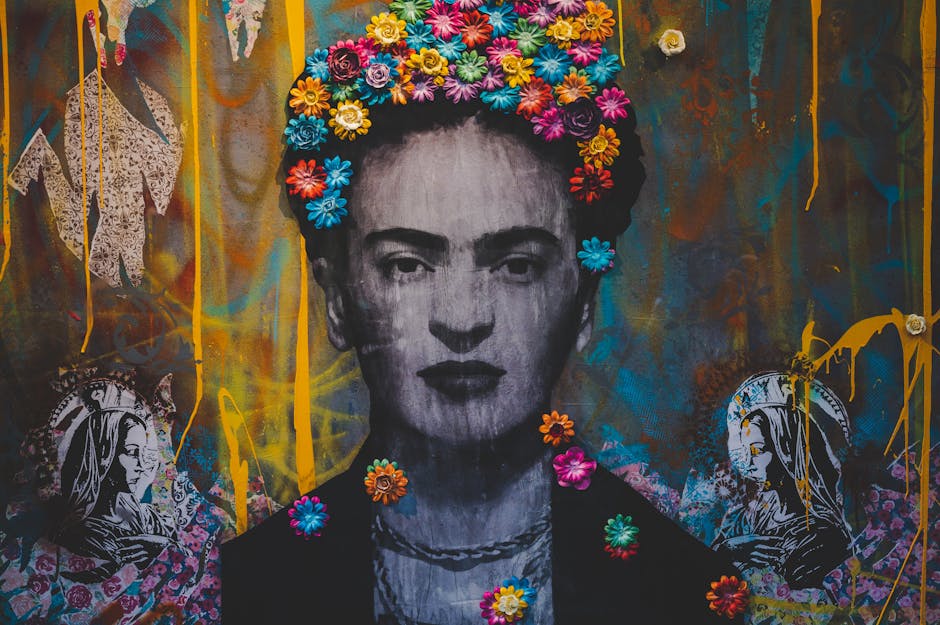Frida Kahlo's life was a blend of joy and suffering, resilience and pain. Her journey from childhood marked by illness to an adulthood filled with both physical and emotional trials shaped her into an artist whose work continues to resonate deeply. Through her paintings, she transformed her experiences into profound expressions of human experience, inviting us to witness her struggles and celebrate her strength.
Early Life and Medical Conditions
Frida Kahlo's childhood was marked by both joy and suffering. Born in 1907 in Coyoacán, Mexico City, she faced polio at age six, which left her right leg thinner and weaker. Despite this, she remained active, participating in activities like swimming and soccer.
At 18, a devastating bus accident changed her life's trajectory. The incident left her with severe injuries, including a broken spine and pelvis. Months of bed rest followed, during which she began painting using a mirror above her bed and a special lap easel. This period planted the seed for her iconic self-portraits.
Kahlo's art became a reflection of her physical pain and mental anguish. Her first self-portrait aimed to capture her reality, replete with sorrow and suffering. Each stroke echoed her daily pain, yet also showed her determination.
The Mexican Revolution, which occurred during her youth, influenced both her art and political beliefs. Attending the prestigious National Preparatory School, she was among just 35 girls in a school filled with the intellectual elite. There she met Diego Rivera, initiating a relationship that would significantly impact her life.
The 1925 accident redefined Kahlo's sense of self and artistic expression. Her paintings became mirrors reflecting her inner turmoil and physical fragility. Canvases turned into chronicles of her pain, blending realism with surrealism.
"Without the bus accident, Frida might never have painted."
Art historians often note this pivotal moment in her life. From her agony, a unique creativity emerged. Pain became her palette, and suffering her brush.
Life handed Frida a challenging path: a body weakened by disease and trauma, but an indomitable spirit. Her youth was a chronicle of battles fought and endurance earned. In her paintings, you see not just an artist, but a warrior chronicling life's challenges.
The Impact of Chronic Pain on Her Art
Frida Kahlo's chronic pain deeply influenced her art, becoming a powerful force in shaping the themes and styles of her paintings. Her works weren't just brushstrokes on canvas but reflections of her suffering and resilience.
Notable Works Influenced by Pain:
- "The Broken Column" (1944): Vividly illustrates her physical torment, depicting herself split open with a crumbled Ionic column representing her spine.
- "Without Hope" (1945): Emerged from a dark period, visualizing her despair during a forced-feeding regimen.
- "The Wounded Deer" (1946): Portrays herself as a deer with her head, pierced by arrows, blending self-portraiture and mythology.
- "Memory, the Heart" (1937): Captures her heartache, depicting her heart lying at her feet, spewing blood.
As her health worsened, the intensity of her work increased. For Frida, art was a way to chronicle her struggles and communicate with her audience about her pain. Her commitment to self-portraiture was born of necessity – a need to express the anguish she felt within.
Kahlo's legacy shows that her art is inseparable from her suffering. She used intense colors, intricate symbolism, and honest self-representation to chart a course from raw pain to profound artistic expression. Her work offers solidarity to anyone who has faced life's challenges, turning suffering into a source of inspiration and connection.
Emotional Turmoil and Personal Relationships
Frida Kahlo's emotional life was as tumultuous as her physical struggles, deeply influencing her art. Her relationship with Diego Rivera was particularly impactful, marked by both love and betrayal.
Significant Works Reflecting Emotional Turmoil:
- "Henry Ford Hospital" (1932): Depicts one of Kahlo's miscarriages, reflecting her physical trauma and sorrow.
- "The Two Fridas" (1939): Examines her emotional duality during her temporary separation from Rivera.
- "Self-portrait with Cropped Hair" (1940): Created after her divorce from Rivera, challenging conventional femininity.
Kahlo's romantic life, including affairs with both men and women, also influenced her work. Throughout her life, miscarriages and emotional turmoil compelled Frida towards a poignant intersection of art and suffering. Her expressions grew more introspective, reflecting not just moments of anguish but a continuous struggle.
In Frida's artwork, we see a spirit shaped by both love and anguish. Her paintings serve as portals into her soul, inviting us to understand her suffering and glimpse the triumph of her enduring spirit. Through her eyes, we not only comprehend her pain but also witness the incredible resilience of the human experience.
Symbolism and Surrealism in Her Work
Frida Kahlo's paintings are rich with symbolism and surrealist techniques that convey her physical and emotional experiences. Unlike many artists who hide behind abstraction, Kahlo's compositions directly reflect her personal struggles through a language tied to her Mexican heritage.
Consider "Self-Portrait with Thorn Necklace and Hummingbird" (1940). Kahlo depicts herself with a necklace of thorns digging into her neck, symbolizing her constant physical pain and invoking Christian martyrdom. The lifeless hummingbird, traditionally a symbol of hope in Mexican culture, hangs from the necklace, suggesting shattered hopes. A black cat and monkey, often present in her works, point to misfortune and personal demons.
In "The Love Embrace of the Universe, the Earth (Mexico), Diego, Me, and Senor Xolotl" (1949), Kahlo merges cosmic and terrestrial elements. Earth holds Kahlo and Diego, signifying sustenance and purity. The inclusion of the moon and sun reinforces themes of suffering and renewal. Her pet dog Xolotl, associated with death in Aztec mythology, hints at an eternal bond transcending mortality.
"Roots" (1943) shows Kahlo lying on the ground with tree roots emerging from her torso, drinking her blood. This visceral connection to the landscape echoes indigenous Mexican beliefs about Earth as a life force. The roots signify both pain and resilience, inseparable from her being.
In "The Dream (The Bed)" (1940), Kahlo lies beneath a festively dressed skeleton, invoking Mexican Day of the Dead celebrations. The floral base of the bed juxtaposes her decaying form, asserting life's fragility and the cultural acceptance of death as part of life's continuum.
Kahlo's fusion of surrealist elements with cultural symbols creates a dialogue between reality and myth, pain and transcendence. Her artworks serve as visual poems where each symbol speaks volumes beyond its immediate impact, elevating her experiences to universal commentary on the human condition.

Legacy and Influence on Modern Art
Frida Kahlo's legacy extends beyond her paintings, influencing contemporary art and therapeutic practices. Her honest portrayal of suffering serves as a mirror to her life and a universal reflection of human pain and resilience.
In contemporary art, Kahlo's blend of personal story and cultural symbolism has inspired artists to embrace vulnerability as a strength. Artists like Tracey Emin and Kiki Smith draw from Kahlo's fearless self-exploration, creating works that delve into personal trauma and identity. Emin's "My Bed" (1998), featuring her actual bed in disarray, echoes Kahlo's raw, candid approach to personal experiences.
Kahlo's Influence in Therapeutic Settings
- Art therapists use her paintings to help patients articulate pain and navigate recovery
- "The Broken Column" and "The Two Fridas" initiate conversations about loss and identity
- Her work acts as a catalyst for confronting and processing complex emotions
Kahlo's influence thrives in community art workshops, therapy sessions, and educational programs, promoting mental well-being. Institutions like the Frida Kahlo Museum ensure her story continues to inspire new audiences to embrace vulnerability and channel it into creativity.
Her unvarnished portrayal of personal torment resonates in contemporary dialogues about mental health and artistic expression. Kahlo's legacy guides those who face their struggles through art, proving that pain can become a source of beauty and resilience.

Frida Kahlo's legacy shows how art can confront and transcend pain. Her ability to turn suffering into evocative masterpieces continues to inspire. In her vivid canvases, we find not just an artist but a warrior, whose spirit endures through the beauty captured in every brushstroke.
"I am not sick. I am broken. But I am happy to be alive as long as I can paint."1 – Frida Kahlo


























